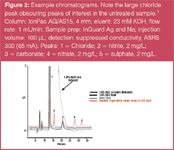Matrix Elimination — In-line Removal of Chloride using InGuard Ag and Na Cartridges
LCGC Asia Pacific
Dionex Application Note
Bernard G. Sheldon,1 Rida Al-Horr2 and Rosanne Slingsby,1
1Dionex Corporation, Sunnyvale, California, USA,
2Dow Chemical, Houston, Texas, USA.
In ion chromatography, the presence of a large amount of matrix ions makes quantification of the target ions difficult. Selective removal of matrix ions — matrix elimination — can be performed by treating a sample with a solid-phase extractant. Halides can be removed by precipitation with silver, which is present as a counterion in a cation-exchange resin. A subsequent treatment with a cation-trapping column removes residual dissolved silver ions.
When analysing a sample for nitrite, it is important to maintain a high pH to preclude oxidation of nitrite to nitrate, which occurs readily at low pH. Therefore, sodium ion (Na+) should be used as the counterion on the silver-trapping column.
Solid-phase manual extraction columns, such as OnGuard II cartridges are useful for processing a limited number of samples; they are discarded after use with a single sample. Newly introduced InGuard cartridges provide automated in-line matrix elimination capabilities, which reduce sample-processing costs, increase processing reliability and enhance ease-of-method documentation and transfer.
InGuard cartridges are used in an ion chromatograph to treat samples before they are injected. The sample is metered with a sample loop and transferred to a concentrator column after being passed through the InGuard cartridge or cartridges. While InGuard cartridges have capacities similar to their OnGuard analogues, the InGuard cartridges will only be exposed to a small amount of sample per injection and, therefore, can be used many times before they are exhausted.
Experimental
A Dionex ICS-3000 system with a DP dual pumping system and a detector compartment equipped with two 6-port valves was used here.
The first valve was a standard high-pressure 6-port injection valve equipped with a 100 μL sample loop. The second valve was a 6-port high-pressure valve installed on the automation manager of the DC. An InGuard Ag and an InGuard Na cartridge were plumbed in series between the two valves. The second pump transferred the sample from the sample loop through the cartridges and onto a concentrator column (Figure 1).

Figure 1
The passage of the sample through the InGuard cartridges may cause some dilution and band-broadening of the sample. A concentrator column traps and concentrates the sample into a small volume before injection onto the analytical column.
Results and Discussion
This application demonstrates the utility of a fully automated method with new InGuard Ag and Na in-line matrix elimination cartridges for removal of chloride from a sample before injection. If not removed, a 1.6% sodium chloride sample, as the one being analysed, would overwhelm the capacity of the analytical column used. The result would be an offscale peak with no resolution of the analytes of interest (Figure 2).

Figure 2
InGuard Ag cartridges contain approximately 5 mEq of silver ion, which is sufficient to remove the chloride from approximately 100 injections of 100 μL each of a 1.6% sodium chloride solution.
OnGuard, IonPac and ASRS are registered trademarks and InGuard is a trademark of Dionex Corporation.

Dionex Corporation
1228 Titan Way, PO Box 3603, Sunnyvale, California, USA
tel. +1 408 737 0700 fax +1 408 730 9403
Website: www.dionex.com

Polysorbate Quantification and Degradation Analysis via LC and Charged Aerosol Detection
April 9th 2025Scientists from ThermoFisher Scientific published a review article in the Journal of Chromatography A that provided an overview of HPLC analysis using charged aerosol detection can help with polysorbate quantification.















